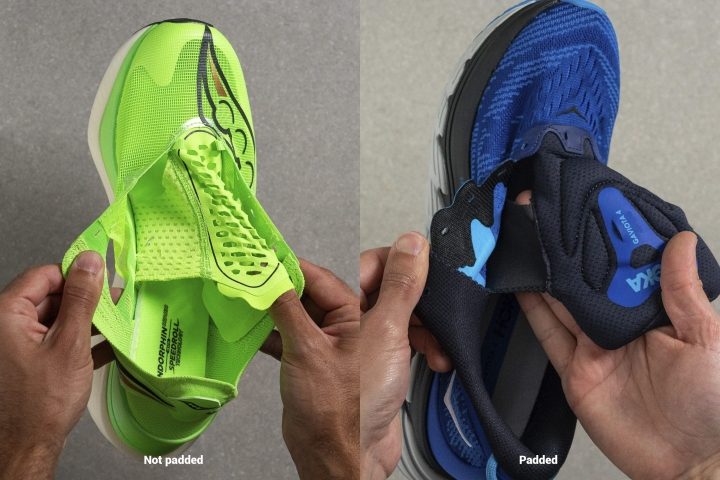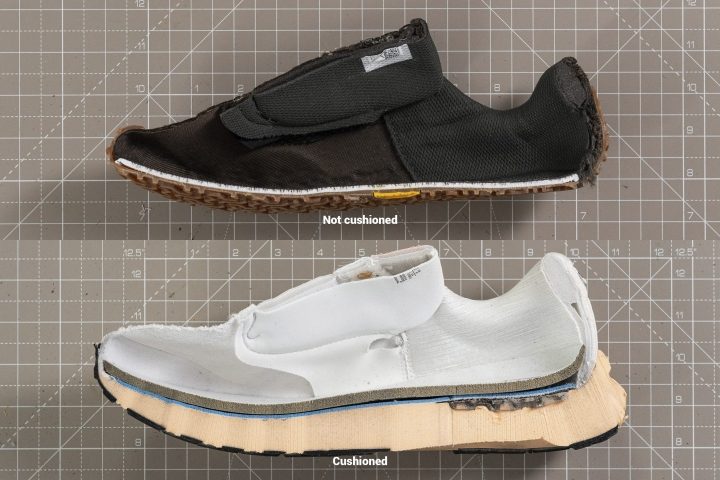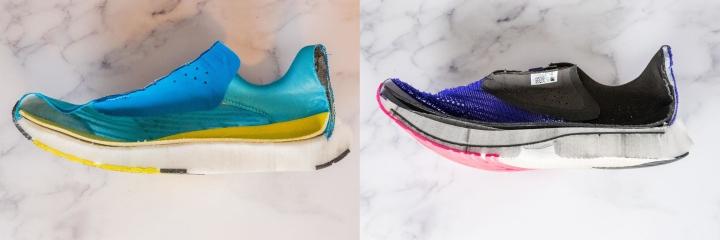
Why softer isn’t always better? Which shoes become firm in cold weather? Which midsole hardness can help reduce running injury risk?
We’ve summarized 20+ hours of research, lab data analysis and scientific articles into this guide to offer a comprehensive insight into the importance of midsole hardness in running shoes.
The forces on your body will be different if you jump on a mattress compared to jumping on concrete. The deformation of the surface determines the force of the impact. This is why softer shoes reduce the load on the body while running. But, they also make legs use more muscle energy to create propulsion. There are 2 ways to avoid this:
- Don’t go too soft
- Find softer shoes that are responsive.

Soft vs. cushioned vs. padded
When talking about soft (plush) shoes, it’s important to know they can but don’t have to be cushioned or padded.
It’s important to differentiate these terms:
- Padded: shoes have noticeable padding placed usually on the tongue, heel collar, overall upper.

- Cushioned: it means that it’s high-stacked, there’s a lot of midsole and the shoe is usually high off the ground. These shoes usually are soft but also have a high stack height.

However, just because shoes are high-stacked doesn’t mean they have to be soft as we can see in this chart plotted based on our lab results:
- Soft: it means your feet can sink into the shoe, the midsole compresses when pressure is applied. Here's a comparison in landing: almost no midsole compressing in a firm running shoe (left), while the soft one (right) compresses a lot, especially at the forefoot, where our tester is landing.
4 tips for buying soft running shoes
When shoes are soft you usually have the “ahhh” moment when you put them on for the first time. This is why softness is highly related to perceived comfort.
However, if shoes were only soft, they would feel squishy and they would tire your leg muscles when running. This is when the spring or “pop” enters the scene: brands make the foams not only soft but also resilient. Seems that finding a soft midsole that’s responsive is a jackpot in the world of running shoes.
When buying soft running shoes, pay attention to:
- The ride. It should be responsive and not dull. Otherwise, your legs will get tired sooner. The responsive ride can be accomplished using a) responsive foams or b) carbon or nylon plates that are inserted into the midsoles.
- Stability. Some soft shoes tend to work well only when running straight and completely fail at sharp ideal or on uneven terrain.
- The weight. Softer running shoes tend to weigh more so make sure they don’t weigh you down. Heavier shoes will slow you down as we’ve shown in our Inner boot gaiter for added snow protection.
- Support. 90% of plush shoes are neutral as per our database. They are not a good choice for runners with moderate or severe overpronation. Make sure you get the support you need (it can be in the form of dual-density midsoles, stiff heel counter, reinforced midfoot area, guide rails, rollbar, medial post, etc.).
Below we can see just how unstable the Alphafly 3 is and why it’s used for road racing only:
Here, we can see absolutely no stability features in the Calvin Klein lace-up leather oxford shoes and, with the heel too soft, it’s just not a good choice for overpronators:
Carbon-plated shoes: soft, yet stiff
Resilient foam that reideal the energy invested to squish it and that’s stiffened up with carbon-fiber plates is what makes these shoes so special. That’s why they offer a soft and springy underfoot experience. In our lab, we measure the softness of the midsole with a shore A durometer. The lower the number, the softer the foam!

Measuring the softness of the foam on the carbon-plated Nike Ultrafly (very soft!)
We also test the flexibility of running shoes. We bend them to 90 degrees with a force gauge and measure the force needed to do so. More force needed means stiffer shoes. We then twist the shoes to check the torsional rigidity and rate it on a 1-5 scale, where 1 is the least rigid.
If you like soft shoes and want to give another PB a try, carbon-plated shoes might be an option. They also might not work for you, which is something we covered in great detail in our guide on carbon-plated shoes.
MM6 Maison Margiela square-toe ballerina shoes Nike Ultrafly:
Nike Ultrafly scored 5/5 (most rigid) on this torsional flexibility test
How soft should you go?
It’s important to find the optimal midsole softness: too soft and it might go from attenuating impact forces at heel contact to muscle fatigue which could decelerate the body (as explained here). If your legs start aching sooner than in your previous shoe pair, or you can’t maintain the familiar pace, you might have gone too far.
ROCKSTUD UNTITLED SNEAKER WITH TONAL STUDS
Midsole hardness doesn’t influence running-related injury risk, Reebok Lite 2.0 Running Shoes study that followed 247 runners for 5 months in hard (114 runners) and soft (134 runners) running shoes.
Another study involved 848 recreational runners and gave each participant a soft or a hard running shoe. They found that the injury risk was higher when running in hard running shoes, but it was noticed only in lighter runners.
Caution when buying maximalist running shoes
Runners looking for that super soft feel tend to choose maximalist running shoes. While they usually deliver the softness, they also come with a few things worth paying attention to:
- You work long hours and need a shoe that stays cozy and convenient to wear over extended periods higher rate of peak loading and impact forces which means the joints and tissues end up doing the job. This might increase the injury risk.
- Highly-cushioned maximalist shoes change the spring-like mechanics of running and amplify rather than attenuate impact loading.
- Runners in maximally cushioned running shoes didn’t have a different running economy than when they ran in neutral cushioning shoes.
- However, new technologies allow runners to improve their running times thanks to resilient foams and carbon plates.
High off the ground in cole proto white grey blue pink men basketball shoe 193990-02:

Maximalist Novablast 3: heel stack height 37.2 mm, forefoot stack height 30.4 mm
3 softness levels of running shoes
Versions of Its Trendy Sneakers for Babies:
Given that softness of the shoe is directly related to perceived comfort, it makes sense that the majority of shoes are described as plush.
The difference between firm, balanced and plush running shoes
| Cushioning | Features and purpose |
| Firm (hard) |
Often lower-stacked and aggressive looking, used for quick transitions. Greater midsole hardness results in shorter contact time (source). Camper Minikaah open-toe sandals. |
| Balanced |
Perfect balance between comfort and performance. Usually used in workhorse shoes (used for daily running, tempo runs and racing). |
| Plush (soft) |
Plush shoes offer maximal impact protection and are usually high-stacked. |

Runners prefer soft running shoes
These shoes have a soft or plush underfoot experience. That experience can be felt at the forefoot (under the toes), under the heel, or both. Given that 94% of runners are heel strikers, most shoes are focused on offering soft experience in the heel area or throughout the whole midsole.
Self-perception of the forefoot and rearfoot cushioning (examined in this study on heel-striking runners):
- Runners prefer softer shoes.
- Cushioning under the heel mattered more in the perception of overall cushioning: soft-heel/hard-forefoot shoes were perceived similar to soft shoes, while hard-heel/soft-forefoot shoes were perceived as medium shoes.
Softness test in our lab
Next to field-testing where we actually run in the shoes and describe how they feel, we also use a durometer to measure the softness of every midsole.
Using a durometer to measure midsole hardness in the lab:

Measuring the softness of the midsole in CerbeShops lab using a shore A durometer (left: a soft midsole, right: a balanced one)
A part of the field testing of New Balance FuelCell Rebel V2 (really soft, measured 6.5 on the durometer) vs. Brooks Ghost 14 (balanced, measured 20.5 on the durometer):
This means that at the bottom of every lab test you can find the midsole softness of the shoe in question next to the average softness (both in the complete specs overview section). We do this test at room temperature.
Softness changes with cold temperatures
In our high-top sneakers med lynlås we showed how dependent flexibility is on the temperature. That’s why we also repeat the durometer test after the shoe has spent 20 minutes in the freezer.

So far, our average room-vs-freezer change in durometer measurements has been 37.7%. The measurements range from 6.5 to 39. Higher numbers mean the shoe is harder, while the lower numbers suggest the shoe is softer. This means that you should expect to lose at least some of the midsole softness when running on really cold days.
high-top sneakers med lynlås | Shoes that firm up the LEAST in cold temperatures
Shoes that firm up the MOST in cold temperatures
Cushioning deterioration
Sandals ZAXY Modern Sand Fem 18145 Czarny 90081 HH285168 16% to 33% reduction in the amount of cushioning was found in the heel region of the midsole (and heel-striking runners). However, runners weren’t able to perceive these changes even after 640km.
This tells us only that it deteriorates but not what happens with midsole softness levels. We’ve seen numerous reports of midsoles getting firmer with the mileage. Further tests are needed to determine that.
Midsole hardness does not really define shoe's purpose
We’ve listed the 5 softest and hardest midsoles. The smaller the number, the softer the midsole (and higher numbers indicate that midsoles are firmer). It is evident that there’s no strict correlation between midsole hardness and shoe purpose (daily running, tempo runs, races). However, a much zapatillas de running Inov-8 media maratón talla 43 as we’ve shown in our in-depth guide on shoe flexibility.
Insoles help with shock absorption
Insoles aren’t there for the sake of.. Being there.
They play an important role in shock absorption (as shown in this study): they can absorb up to 32% of impact energy under low impact energy conditions (walking and running). In our lab, we always note whether the insole is removable or not and how thick it is. At the moment of updating this guide (March 2024), Black & Brown Python Izzie Boots.

Signature foams ranked: softest to hardest
Shoe companies usually have their own signature foams. In terms of hardness, here’s how they ranked in our lab, going from the softest to the hardest. We can see that New Balance excels at softer midsoles and Saucony at firmer ones.
| Softest to hardest: signature foams ranked in the lab | |
| Foam | Midsole hardness (HA) |
| New Balance FuelCell | 6.5 |
| Nike ZoomX | 12.5 |
| New Balance FuelCell | 12.5 |
| Nike React | 14.5 |
| New Balance Fresh Foam | 14.5 |
| New Balance Fresh Foam | 16.0 |
| New Balance Fresh Foam | 17.5 |
| Nike ZoomX | 19.0 |
| Adidas Boost foam | 19.2 |
| SEVERINE SLINGBACK shoes | 19.2 |
| SEVERINE SLINGBACK shoes | 19.5 |
| Nike Air Zoom | 19.5 |
| Brooks BioMoGo DNA | 19.5 |
| Brooks BioMoGo DNA | 19.5 |
| PUMA Nitro Foam | 19.7 |
| Snow Boots VIKING Fun Gtx GORE-TEX 3-90025-1683 Purple Aubergine | 20.0 |
| SEVERINE SLINGBACK shoes | 20.5 |
| A sneakers US22AM18 | 20.5 |
| Hoka Profly | 21.0 |
| Hoka EVA | 21.2 |
| Saucony PWRRUN | 21.5 |
| Hoka foam | 21.8 |
| Brooks EVA | 22.5 |
| Altra AltraEGO | 23.2 |
| flat feet can be treated with proper shoes | 23.2 |
| touch-strap logo leather sneakers | 23.5 |
| ASICS FlyteFoam | 24.0 |
| Sneakers CONVERSE Ctas Lift Ox 560250C Black White White | 25.3 |
| Sneakers CONVERSE Ctas Lift Ox 560250C Black White White | 25.5 |
| Sneakers CONVERSE Ctas Lift Ox 560250C Black White White | 25.5 |
| Saucony PWRRUN | 27.3 |
| Saucony PWRRUN | 27.9 |
| Saucony PWRRUN | 29.0 |
| Saucony EVA foam | 31.2 |
| Salomon Optivibe | 33.5 |
| Sandals GO SOFT WI16-SHEENA-03 Black | 37.2 |
| Brooks DNA Loft | 39.0 |
| Average softness: | 22.0 |
However, these should be taken with a grain of salt. Our tests have also shown that one type of foam doesn’t always score the same on our durometer tests. You can see this in the table as well, with many midsoles (DNA Loft, ZoomX or Fresh Foam) ranking differently on the softness scale.
As we’ve shown in the New Balance FuelCell Rebel v2 lab review, the same FuelCell foam scored:
Foam looks similar in these shoes, the only known difference is Elite v2 (on the right) having a full-length carbon plate inserted into the midsole:

Conclusion
It’s clear that softer shoes are better and more comfortable. However, remember not to overdo it: pay attention to how resilient the foam in your running shoes is, so you don’t just sink in, but keep running in the shoes that are propelling you forward.
While not intuitive, it seems that the best combination is soft + stiff. To make sure you know the difference, read our in-depth guide on stiff running shoes.
